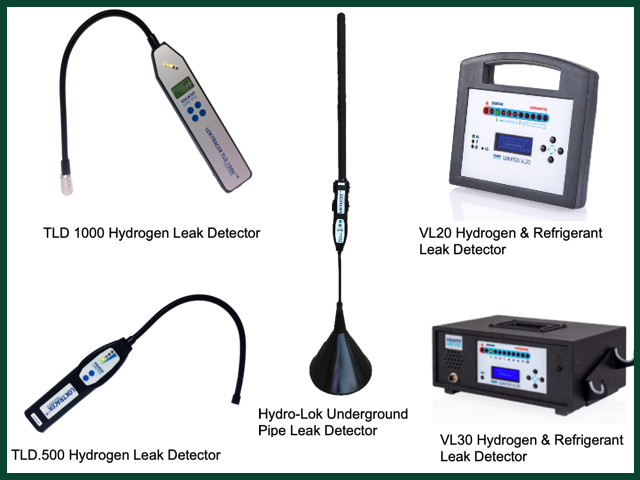
Hydrogen Leak Detection Products
TLD.1000 Hydrogen Leak Detector
Quantitative Output for Service & Low Scale Production Applications
TLD.500 Hydrogen Leak Detector
High Sensitivity for Service Applications
VL20 Hydrogen & Refrigerant Leak Detector
Production Applications Like HVAC & Automotive
VL30 Hydrogen & Refrigerant Leak Detector
Very Low Leak Rate Production Applications like Refrigerators
Hydro-Lok Underground Pipe Leak Detector
Subsurface & Underground Pipe Leak Applications
Product Information- (Pricing Link to Apex Site)
VL20 Hydrogen & Refrigerant Leak Detector
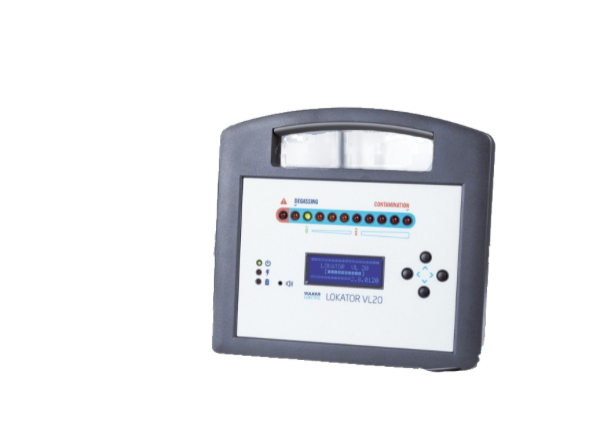
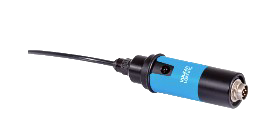
The VL20 is a great choice for production applications where the leak rate is 0.10 oz/yr of refrigerant equivalent. Applications such as HVAC coils, HVAC Systems, automotive lines & systems and ice machines.. The VL20 can be calibrated with a reference leak and provides a quantitative display,
VL30 Hydrogen & Refrigerant Leak Detector
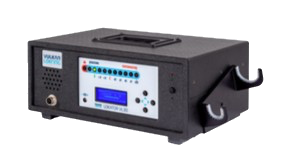
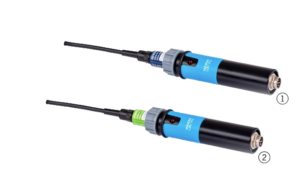
The VL30 is a superior choice for production applications where the leak rate is 0.0.5 oz/yr of refrigerant equivalent (one ounce in 20 years). Applications such as refrigerators, refrigeration systems and ice machines. The VL30 can be calibrated with a reference leak and provides a quantitative display,
TLD.1000 Hydrogen Leak Detector

The TLD.1000 is a great choice for small scale production applications where a quantitative readout of leak rate is needed.
The TLD.1000 displays in ppm (parts per million) of H2. Two sensors are provided, first is a non-discriminatory sensor sensitive to H2 and other gases. Once a signal is indicated, the second H2 only sensor is initiated to indicate a H2 leak rate reading,
TLD.500 Hydrogen Leak Detector
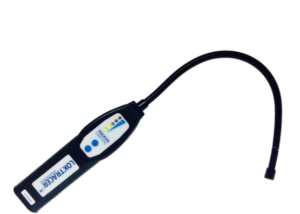
The TLD.500 is a great choice for service applications where a cost effective solution is desired.
The TLD.500 has a progressive light display to indicate leak rate reading. In addition, a frequency changing alarm indicates leak and pinpoint location.
Hydro-Lok Underground Pipe Leak Detector
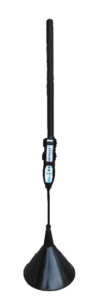
The Hydro-Lok Underground Leak Detector (Subsurface Leak Detector) uses the TLD.500 on a ground probe to located leaks in underground pipe. Applications are usually water line leaks but can also be gas lines and steam lines. System includes a H2 regulator and air hose.
Hydrogen Leak Detection
Sniffing Using 5% Hydrogen/95% Nitrogen Tracer
Using hydrogen/nitrogen as a tracer gas provides a significant cost advantage to helium sniffing, while offering a 1000x increase in leak detection sensitivity over bubble testing methods. The TLD.1000, VL20 & Vl30 Hydrogen Leak Detectors provide a quantitative leak rate display in ppm with leak rate sensitivity to as low as 1 ppm. The TLD.500 & Hydro-Lok Hydrogen Leak Detector is a cost effective option perfect for when leak location is the most important feature in either above ground or sub-surface leak locations.
Hydrogen vs. Helium Leak Detection
Helium sniffing was the preferred method of tracer gas leak detection for many years. However, increased equipment cost and helium availability has limited the applications in which tracer gas could be used. As a result, users have had to employ less sensitive technology methods. Helium leak detectors can be either mass spectrometer or thermal conductivity technology. In comparison to hydrogen tracer mixture, helium mass spectrometers are 20x more costly than hydrogen, while helium thermal conductivity suffers from decreased sensitivity and more frequent service. Also, both helium methods pull a gas sample into the probe which can cause clogging of the probe. Our hydrogen leak detectors avoid this issue by being "impact" detectors, meaning no gas is drawn into the detector.
Hydrogen vs. Bubble Testing
Bubble testing is the accepted low cost method of finding leaks. Using soap and water solutions, bubbles are formed at the leak location. An alternative method is to submerge the test article in water and look for bubbles. However, these methods are subject to lower sensitivity. Using a hydrogen mixture tracer gas provides at least a 1000x increase in sensitivity. Furthermore, leaks that do not produce a bubble can be detected with either the TLD.500 or TLD.1000 Hydrogen Leak Detectors in service type applications while for product production, the VL20 Hydrogen Leak Detector or VL30 Hydrogen Leak Detector are the better choices.
How Our Hydrogen Leak Detectors Work
Our hydrogen leak detectors use a hydrogen sensing chip that activates in the presence of hydrogen. The hydrogen sensing chip is so sensitive that it can detect trace amounts of hydrogen from and exhaled breath! Leaks are found by using a a 5% Hydrogen 95% Nitrogen tracer gas mixture, then placing sniffer tip of the Hydrogen Leak Detector along the suspected piping. When a leak is present the Hydrogen Tracer Gas will escape and LOKtracer will react. When a leak is detected the Hydrogen Leak Detector increases its beeping and amount of lights on the panel in relation to the amount of hydrogen detected. This process works even for buried or covered equipment as long as it is permeable to gas.
Hydrogen Leak Detection Applications:
Leak Checking Applications in Manufacturing
- HVAC Systems
- Refrigerators
- Refrigeration Valves
- Heat Transfer Systems
- Vacuum Vessels
- Supermarket Cold Displays
- Inflatables
- Other Pressurized Systems
Service Type Applications
- Underground Water Lines
- Underground Transmission Lines
- Above and Underground Gas Lines
- Gas Storage Tanks
- Refrigeration Systems in Retail and Supermarkets
- Swimming Pools and Pool Piping
For more info on common applications for hydrogen leak detection.
Frequently Asked Questions
Q. Isn’t hydrogen dangerous and explosive?
A. In 100% concentration, that is the case. We always recommend using 5% hydrogen mixed with 95% nitrogen because hydrogen is not combustible in nitrogen until hydrogen represents 5.7% . This mixture is green label non-combustible, therefore it will never have the ability to combust or increase the intensity of a fire.
Q. Will the hydrogen in the mixture settle out and cause an unsafe condition?
A. No, it remains mixed at all times. Inert gases cannot stratify. If they did the gas that makes up our atmosphere would stratify into pockets of disparate gases resulting in all of our deaths.
Q. Which is better as a tracer gas, hydrogen or helium?
A. In the past, helium was the best tracer gas because of its availability, the reliability of equipment to detect it, and its low background amount in air (0.5 ppm). Using hydrogen mixture as a tracer gas has become more popular because instruments like the TLD.500 and TLD.1000 have drastically improved in being able to find small leaks. Also, helium is in short supply and expensive. Another benefit is that hydrogen also has a low background in air (0.05 ppm).
Q. What is the cost of the 5% hydrogen, 95% nitrogen tracer gas compared to helium?
A. 5%H2/95% N2 is 15-25% the cost of 100% helium. While there are efforts to lower the helium concentration to also lower the cost, that affects the sensitivity of the helium leak detector to find smaller leaks. Also, because the helium/nitrogen is now a mixed gas, there is a charge to mix it at the factory. Therefore, cost savings by lessening helium amounts in the mixture may not significantly reduce overall cost.
Q. Where have hydrogen leak detectors been used in the past?
A. Hydrogen leak detectors were used extensively in locating leaks during the telecom boom of the late 1990s. Since then, hydrogen leak detectors have improved, leading them to be used in applications where lower detection of leak rates is required. In the future hydrogen leak detectors will be used for detecting and locating leaks in underground water lines or pipes. Water has increasingly become a strategic resource and leak detection is getting more important. Our TLD.500 starts in price at $998, allowing more plumbers and leak detection companies to be able to employ tracer gas leak detection into their portfolio of capabilities.
Product Questions
Q. What is the difference in the VL20 & VL30?
A. Both the VL20 & VL30 are excellent in leak testing a sealed product. The VL30 is slightly more sensitive to smaller leaks thus is the choice for applications like home and commercial refrigerators where the life of the product can be 20+ years. The VL20 is the economical choice of leak detectors and can detect both hydrogen and refrigerant with the same sniffer probe.
Q. What size leak can the TLD.500 and the TLD.1000 find?
A. The TLD.1000 shows a quantifiable H2 leak rate and can detect into the single digit ppm values. The TLD.500, while not displaying a quantity of H2, can detect a leak concentration in the 25-35 ppm range. The detection limit is actually smaller but the user cannot always distinguish that low of a signal as a leak.
TLD.500 Leak Rate Capability
TLD.1000 Leak Rate Capability
Demonstrating the TLD.500
TLD.500 Finding Small Leaks
VL20 Detecting H2 & Refrigerant-Same Probe
VL20 Hydrogen Leak Detector Demo
VL30 Hydrogen Leak Detector Response Time
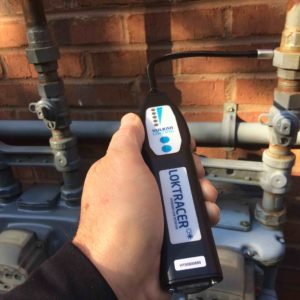
TLD.500 Hydrogen Leak Detector
For Finding Leaks in Underground Piping - Hydo-Lok Sub-Surface Piping Hydrogen Leak Detector

